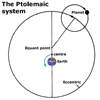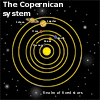Our Solar System has one central star, the Sun. This makes it very easy to define day and night:
- Day occurs when the part of the Earth you are on faces the Sun;
- Night therefore occurs when your part of the Earth faces away from the Sun.
 This
is fairly simple, but why then does the length of day and night vary at
different times of the year and in different places on the Earth's surface?
Another question to ponder is why one person's day in Europe is our night
in Australia?
This
is fairly simple, but why then does the length of day and night vary at
different times of the year and in different places on the Earth's surface?
Another question to ponder is why one person's day in Europe is our night
in Australia?
Our rotating globe
Day and night is caused by the rotation of the Earth on its polar axis
once every 24 hours, hence the combined length of day and night is always
24 hours.

|
Day and night |
Day and night are caused by the rotation of the Earth on its axis. There
are two basic types of day. The Sidereal Day is the time it takes for
the Earth to rotate in relation to the distant stars; its length is 23
hours 56 minutes and 4 seconds.
The Solar Day is the time it takes for the Earth to return to the same
orientation with respect to the Sun; its length averages exactly 24 hours.
The difference arises because the Earth moves about one degree around its orbit over the course of a day, and must rotate a little more for a given point on Earth to exactly face the Sun again. In the remainder of this section, we shall use the term day to indicate the 24-hour solar day.
 Copernican
System
Copernican
System
Long ago, it was generally believed that the Earth was the centre of all
things, with the Sun and other planets orbiting around it. Models based
on this idea were developed by ancient Greek philosophers such as Aristotle
and Ptolemy. However, as we know today, the Earth and other planets revolve
around (or orbit) the Sun and the Earth turns (rotates) on its own axis.
 This
model was put forward by the Polish Astronomer Nicolas Copernicus. He
published details of the Copernican System in 1543, many years after writing
his ideas
down - and then only when he was dying. To the Earth-centric church
of the middle ages, such ideas were heresy, and Copernicus may not have
lasted until 1543 if he'd tried to publish them earlier!
This
model was put forward by the Polish Astronomer Nicolas Copernicus. He
published details of the Copernican System in 1543, many years after writing
his ideas
down - and then only when he was dying. To the Earth-centric church
of the middle ages, such ideas were heresy, and Copernicus may not have
lasted until 1543 if he'd tried to publish them earlier!
The length of day and night
Although the Earth rotates once every 24 hours on its polar axis through
the North and South Poles, day and night do not share the 24 hours equally
- except on two dates, around 21st September and 21st March, known as
the Equinoxes. On these two dates, day and night are each exactly 12 hours
long all over the Earth, except at the North and South Poles where night
and day exchange places on these dates.
 From
22nd September to 20th March, days are longer than nights in the Southern
Hemisphere and correspondingly shorter in the Northern Hemisphere. From
22nd March to 20th September, days are longer than nights in the Northern
Hemisphere and correspondingly shorter in the Southern Hemisphere. This
is taken to the extreme at the North and South Poles, where daylight lasts
for 24 hours for the summer half the year and nights for 24 hours for
the winter half year. That is, a day lasts 6 months followed by a 6 month
night.
From
22nd September to 20th March, days are longer than nights in the Southern
Hemisphere and correspondingly shorter in the Northern Hemisphere. From
22nd March to 20th September, days are longer than nights in the Northern
Hemisphere and correspondingly shorter in the Southern Hemisphere. This
is taken to the extreme at the North and South Poles, where daylight lasts
for 24 hours for the summer half the year and nights for 24 hours for
the winter half year. That is, a day lasts 6 months followed by a 6 month
night.
On an angle
The variation in the length of day over a year is due to the angle, or
tilt, at which the Earth rotates in relation to its orbit around the Sun.
If the Earth's rotation was perpendicular to its orbit, then day and night
would be 12 hours each for the whole year. Because the Earth is tilted
at an angle of 23.5° to this direction, we have more daylight in summer
than we do in winter and the opposite during winter.
Carefully watch the observer in the following animations as the Earth rotates once to see the difference in the length of a day between summer and winter.

|
Summer day and night |

|
Winters day and night |
Summer and Winter Solstice
The longest day of the year, the summer solstice, occurs on 22nd December
in the Southern Hemisphere. In the Northern Hemisphere, this day corresponds
to the shortest day of the year or winter solstice.
Six months later on, 22nd June, the shortest day occurs in the Southern Hemisphere and the longest day in the Northern Hemisphere. Both these days are three months from the Equinoxes.
| Copyright owned by the State of Victoria (Department of Education and Early Childhood Development). Used with Permission. |
|
|||||||||||||||||||||||